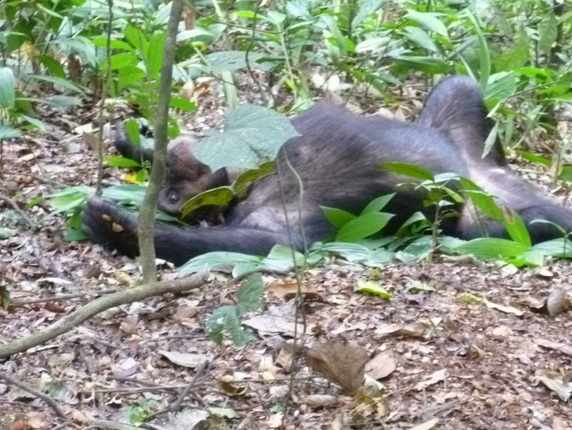|
The first thing I noticed in Uganda’s Kibale National Forest Park was the abundance of butterflies. It looked like petals were falling all around us, a shaken bouquet of iridescent pale blue, lime green, lucid white, pink-spotted, bright yellow, and deep black wings. Everywhere they fluttered.
If a forest is home to so many different butterflies, I thought, what other marvelous, mysterious creatures live here? We had come to track Kibale’s most famous residents: chimpanzees! It’s hard to write chimpanzee without an exclamation point, they are so exciting. I never imagined that I would get to see them--humans’ closest genetic relatives, along with bonobos--in the wild. Yet my guidebook informed me that Kibale is one of the best places in the world to encounter them. Here, amid 351 species of trees and 12 other types of primates, a group of chimps has been habituated to human contact. An experienced tracker can find them about 90 percent of the time, and every day tourists get to spend one hour in their presence for a fee of $150 per person. Our guide was named Ronald. He is Ugandan and has been tracking chimps for 14 years. “They know me well,” he said. He led us up a red road into the park, and then he turned sharply left into the forest. Suddenly we were surrounded by tall trees, strangler figs twisting up trunks, vines cascading back to the earth. Everywhere it was green, but not so dense that we couldn’t make our way. We heard thunder rumbling. After about a half hour of hiking, Ronald turned around and said, “They are here.” We walked a few more steps, and only ten feet away a chimp was stretched out on the ground on its back, an arm hanging lazily above its head. It looked so relaxed, so languorous and at peace. It was taking an afternoon snooze. The chimp glanced in our direction and then looked away, not caring. It was the most beautiful thing to see this animal in the wild, so fully at ease. Several other chimps were in the distance, some sitting, some picking at leaves, some lying down. The alpha male sat not too far away, looking ominous. A tourist got too close and the male suddenly swung a branch in the air. She had violated his space, and he was demanding respect. This chief chimp moved deeper into the forest, and one by one the other chimps followed, using all four limbs, quickly and smoothly. We slowly walked after them, sometimes losing sight of their dark bodies in the shadows and thick of the jungle. Then we came upon a solitary chimp resting its back against a tree trunk, looking around slowly, quietly, meditatively. Perhaps somewhere way, way down the silly strings of this chimp’s DNA lies a genetic tie with Henry David Thoreau and his Walden. We belong in nature, too, I thought. Before our hour with the chimpanzees(!!) had ended, we reached the park’s “grasslands,” which was really a mass of vines and thorny branches tangled with tall stems. Ronald wanted to press on, to see the chimps one more time. “I must try,” he said. So we tumbled through a green vortex, with the jungle grabbing at our legs and arms, leaving us pin-cushioned with pokey seedpods. We were rewarded with an amazing view: a chimp crouched just a few feet away, employing his big strong arm and dexterous fingers to delicately pick something tasty off a plant. So much power used with so much grace.
3 Comments
AJ
1/25/2012 04:08:54 am
Chimpanzees are the f'ing champs of the forest!
Reply
Sue (Peterson) Curtis
1/26/2012 02:36:11 am
Beautifully written, Jennica. Wonderful story.
Reply
Leave a Reply. |
Archives
July 2012
Categories
All
|

 RSS Feed
RSS Feed